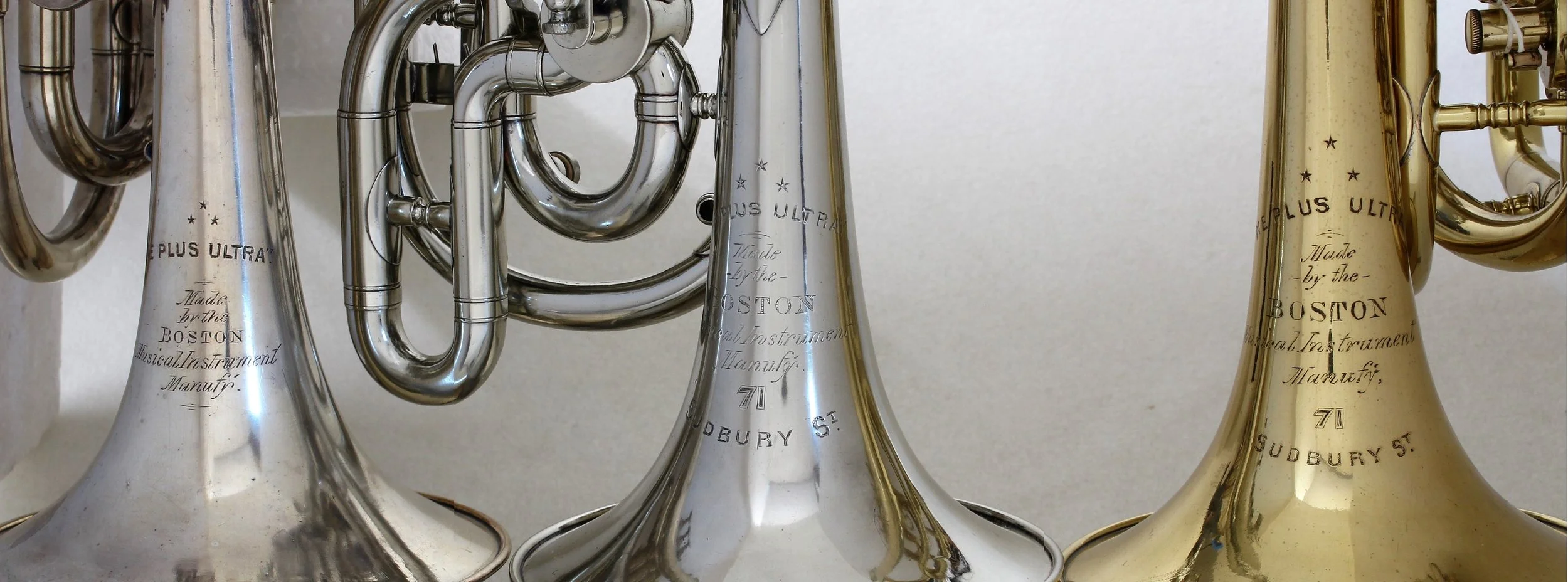Earliest Boston Three Star Cornets
This Boston Three Star Cornet was acquired from the collection of the late Jim Montgomery in Florida. It was the lowest priced of eight Three Stars, being in the roughest condition of the lot. Like most antique instruments, it had been abused and badly repaired/restored during its long life. Jim had owned it for many years and I don't think that he knew the historical significance it holds.
Right side of earliest Three Star Cornet with piston valves.
This is the earliest Boston Three Star Cornet with piston valves that is known so far. There is no precise way of dating it, but it was built in the 1870s, possibly before the prototype Three Star that features Henry Esbachs patent rotary valve mechanism.
Earliest Three Star Cornet, showing the round lyre socket and lack of trademark engraving.
The next photo shows this Three Star Cornet with two other of the earliest of this model that were built at about the same time. These are the three earliest examples of this model known. The development of these models is discussed on another page, but below are described the clues that indicate its place in that history. The second of these is the same as the Orchestra Cornet with four valves that had been made for almost ten years by this time, but with larger bore and bell. The third is the prototype of Esbach Patent Three Star Cornet, made before the patent was granted early in 1879.
Three Star Cornets made about 1878.
It’s alto interesting to compare the engraving on these three cornets. The two with rotary valves have almost identical engraving, while the piston valve cornet has engraving the same as earlier instruments, but with the stars and Latin phrase added. This doesn’t prove anything, but indicates the possibility that it was made before the other two.
Engraving on the three earliest of this model.
Like other very early Three Star Cornets, this has the larger bore, measuring about .487" and valve guides fixed on the pistons. What sets it apart from the other early examples is the narrow third slide crook, the round lyre mount socket and the lack of trade marked decorative wreath that is engraved around the signature on (almost) every Three Star Cornet made after about 1880. There is only a handful of other Three Star Cornets without the wreath including the Esbach patent cornet and one with four rotary valves pictured above, several others with piston valves and the wider third slide crooks (one with the smaller, .463" bore and C cornet bell!) that were made shortly after this one and another with rotary valves in the collection of the First Brigade Band in Wisconsin. The latter, quite surprisingly, has a serial number that dates it to 1907, more proof that Boston was willing to take custom orders for special instruments, even after the deaths of all the founders of the company.
Left side of the earliest Three Star Cornet with piston valves, showing the narrow third slide crook.
The next photo shows two more cornets with the same valve section. On the left is one with no stars engraved on the bell, that is featured on its own page. This cornet was made for a very short time while Boston was putting a lot of effort into developing these new models during the mid-1870s leading to the introduction of the Two and Three Star Cornets. At that time it became the One Star Cornet. The extreme rarity of this model, with or without stars (about 7 known) and none with the wider third slide crook, indicates that it must have been dropped very soon after. On the right is Bob Hazen's Two Star Cornet (now in the collection of the Boston MFA, made of nickel silver with copper bell, that also dates from this period and has the same narrow third slide crook.
Boston “proto-One Star” cornet, about 1877 and Two Star cornet, about 1878.
Below is an advertising card from the 1870s that shows a piston valve cornet with a very similar looking valve section, the text on the back introduces the “New Bb Cornet”. This card makes no mention of the "Star" or Esbach models and a reasonable theory is that this is the "Pre-Star" large bore cornet. Interestingly, the text describing the "New Bb Cornet" on the reverse is identical to that describing "The Famous Three Star Cornet" in the 1881 Boston catalog.
Advertising card from about 1877.
Below are two pages from the 1881 catalog showing that Two Star Orchestra Cornets were available with either piston or rotary valves (this is the only case where the earlier Orchestra Cornet and the Two Star Cornet are conflated and indicated that the Orchestra Cornet was available with piston valves) . These are the earliest of the "Star" models that have been found in print and the illustrations show the "modern" Three Star Cornets with the wider third slide crooks but the Two Star with the same image from the earlier advertising card showing the narrow third slide crook. It seems likely that they had switched those to the later design by that time, but hadn't yet had a new illustration engraved.
The last photo shows third valve pistons from three Three Star Cornets. The first is from the cornet featured above and the design is very much like those made by E.G. Wright in the 1860s although with a larger diameter. The second piston is from a Thee Star made about the time of the 1881 catalog (no serial number yet). The last was made later in the 1880s with the smaller .472" bore and the floating valve guide.
Pistons from three Three Star Cornets, made about 1878, 1881 and 1885.
As always, I invite the reader to send me additional information that might correct statements that I make.











